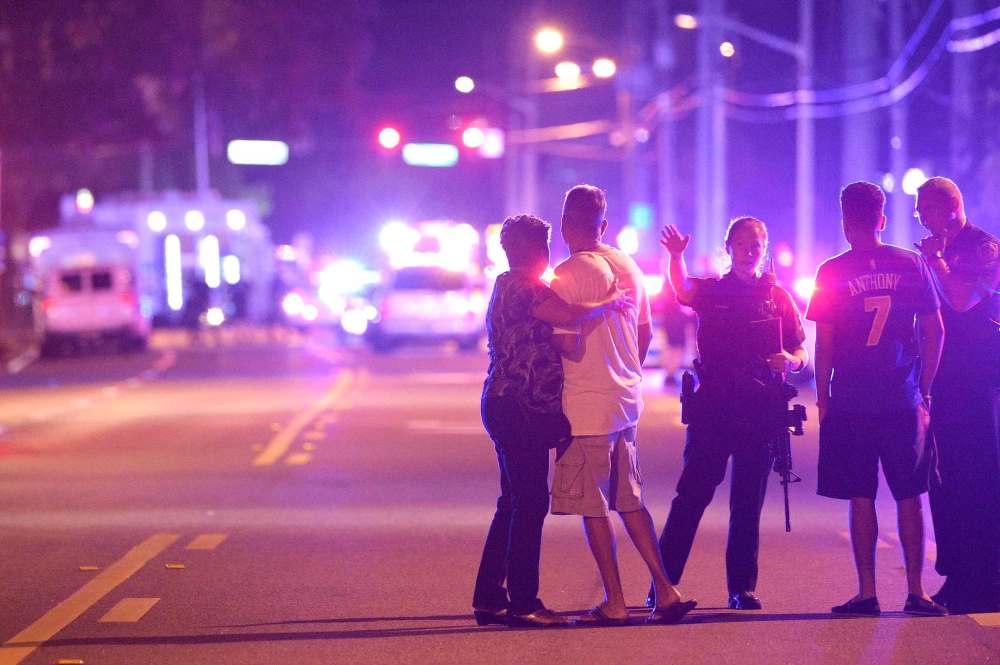Shooter loaded gun with intolerance, hatred
Advertisement
Read this article for free:
or
Already have an account? Log in here »
To continue reading, please subscribe:
Monthly Digital Subscription
$0 for the first 4 weeks*
- Enjoy unlimited reading on winnipegfreepress.com
- Read the E-Edition, our digital replica newspaper
- Access News Break, our award-winning app
- Play interactive puzzles
*No charge for 4 weeks then price increases to the regular rate of $19.00 plus GST every four weeks. Offer available to new and qualified returning subscribers only. Cancel any time.
Monthly Digital Subscription
$4.75/week*
- Enjoy unlimited reading on winnipegfreepress.com
- Read the E-Edition, our digital replica newspaper
- Access News Break, our award-winning app
- Play interactive puzzles
*Billed as $19 plus GST every four weeks. Cancel any time.
To continue reading, please subscribe:
Add Free Press access to your Brandon Sun subscription for only an additional
$1 for the first 4 weeks*
*Your next subscription payment will increase by $1.00 and you will be charged $16.99 plus GST for four weeks. After four weeks, your payment will increase to $23.99 plus GST every four weeks.
Read unlimited articles for free today:
or
Already have an account? Log in here »
Hey there, time traveller!
This article was published 16/06/2016 (3466 days ago), so information in it may no longer be current.
The Orlando massacre has been called the worst mass shooting in United States history. Considering the fact there have been 132 mass shootings in the U.S. so far this year, that’s saying something.
Early Sunday, 49 people were killed and another 53 wounded. The victims were members of or supporters of the LGBTTQ* community, many of them Latino. In terms of deaths, the massacre outpaces the horrific numbers at Viriginia Tech in 2007 (32 killed), Sandy Hook Elementary in Connecticut in 2012 (27 killed) and Luby’s Cafeteria in Killeen, Texas in 1991 (23 people killed).
The deadliest mass shooting in U.S. history, as National Public Radio has observed, was actually perpetrated by U.S. soldiers on the Lakota Pine Ridge Indian Reservation near Wounded Knee Creek in South Dakota in 1890. More than 250, possibly as many as 300, Lakota Sioux were killed. Those victims, a substantial number of whom were women and children, had been charged with no crime and were not engaged in combat.

There have been other mass killings, such as the Mountain Meadows Massacre of 1857, in which 120 people (many of them women and children) were killed after a truce between Mormon territorial militia and newer settlers to Utah was broken, or the Tulsa Race Riot, in which white rioters attacked the black community and nearly 300 people were slain.
True, we tend to think of mass killings as the work of a single gunman on a shooting spree, and prior to the 20th century there weren’t many of those. But what is at issue here, is who was targeted: people who are marginalized.
This is not to make any particular atrocity seem less horrifying by comparing it with others, but rather to put it in context. The victims at Wounded Knee were already being forced off their land by a settler state; many in the black community in Tulsa were still familiar with the horrors of slavery.
If you limit the scope to single-gunman mass killings, the Sandy Hook victims were predominantly children, and the victims in last year’s mass shooting in Charleston, S.C., were attacked in their church by a white supremacist who specifically targeted them because of their skin colour. In both cases, they were marginalized and vulnerable.
So it isn’t an act of random violence when a nightclub known as a safe gathering place for members of the LGBTTQ* community in Orlando is targeted by an angry man. It’s an act perpetrated against people who are familiar with their rights being denied and facing hatred from others because of who they are. It’s an expression of overt violence against people who face the non-physical but all-too-real misery of prejudice and discrimination on a daily basis.
This massacre wasn’t an unfathomable aberration. It was yet another explosion of prevalent hatred.
The Muslim shooter in Orlando, who swore allegiance to Islamic State, has provided grist for the Islamophobes’ mill.
Republican presidential candidate Donald Trump has received plenty of free ink for his broadsides at Muslims, Mexicans and immigrants, and one of his first reactions on social media to the mass shooting in Orlando was, “Appreciate the congrats for being right on radical Islamic terrorism, I don’t want congrats, I want toughness & vigilance. We must be smart!” Trump was already trying to use a fatal expression of homophobia to fan the flames of Islamophobia.
The thing is, he wouldn’t say those things unless he felt he had a receptive audience. There’s plenty of covert and overt hatred seeking expression, and an eruption of violence such as what happened in Orlando is built on it.
The horror in Orlando may force a new debate on gun control south of the border. It would be more helpful if it forced a real discussion on the roots of such violence: the intolerance and hatred that leads some to kill and the privilege that allows many others to ignore it — until the next massacre.





